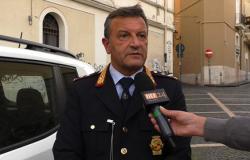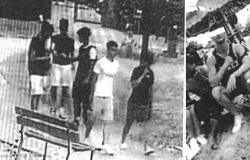
Very important was his friendship with Marcello Casco who guided him with his great experience and advice. Among other things, he introduced him to Puff, Lando Fiorini’s cabaret. There alternated Francesco De Gregori who sang “Roma Capitale”, Antonello Venditti who played the piano and sang his first songs, the duo Stelio and Edoardo (Edoardo de Angelis, who later founded the Schola Cantorum). But also the Piadena Duo (Chitò and Merli) with “L’uva fogarina”, Daisy Lumini who performed whistling and Beppe Chierici with Brassens’ songs, and a thousand others.
Rino set some lyrics by Marcello Casco to music, wrote the first songs, looked for contacts with record companies. Together with one of his closest friends, Antonio Salezzari, who was the first to believe in him, he went to the RCA, just outside Rome on the Via Nomentana, where he happened to glimpse the unreachable Prince (Maurizio Vandelli leader of Equipe 84), Gianni Morandi or Ennio Morricone, but the time was not yet ripe.
During a trip to Milan, he proposed to the Blue Bell record company; he met Fabrizio De Andrè there who impressed him greatly with his human availability. Before Rino performed, Fabrizio tuned him the guitar with great skill and extreme ease.
During the return journey from Milan to Rome by train, the two friends composed a song dedicated to the events of the Cassino friars, accused of cigarette smuggling. It was the beginning of the irony that would permeate Rino’s songs: in it it was argued that the friars justified their activity with religious arguments linked to the parallel between prayers and cigarette smoking: both went up to heaven “so instead of praying you can smoking is fine” concluded the sermon of the imaginary Brother Leone. The two friends also performed in a club located near the Vatican called Blow up.
Together with his studies as a surveyor, he approached the stage with an interest in theater and only later attempted the path of pop.
After his first performances at the Folkstudio, he was discovered by Vincenzo Micocci, and his recording debut took place in 1973: under the pseudonym Kammamuri’s, he released the single I Love You Marianna for It (Jaqueline on the B side); produced by Antonello Venditti, Piero Montanari and Aurelio Rossitto, sound engineer at Studio 38, where the album was made (acronym for RosVeMon, from the initial of the surnames). I Love You Marianna might make you think of marijuana but in reality here Rino, despite playing on the double meaning, refers to the affection that binds him to his grandmother Marianna, with whom he played as a child. In those years the singer formed a particular friendship with some of his colleagues under contract with Vincenzo Micocci’s It, some of whom were still little known at the time, such as the songwriters Antonello Venditti, Francesco De Gregori, Lucio Dalla, the actor Marco Messeri.
In 1974 he released his first album, Ingresso libero, which however did not obtain particular sales or critical success, despite already showing signs of the whimsical, provocative and innovative style that would characterize his entire career. Among the songs present there are For example I like the South, a song already known because it was recorded the previous year by Nicola Di Bari with slightly different lyrics, and Your eyes are full of salt. The meeting with Nicola was, according to Rino, fundamental for the beginning of his career.
Success came the following year with the 45 rpm single. But the sky is always bluer.
Rino Gaetano during one of his performances
In 1978 Rino Gaetano took part in the Sanremo Festival with the song Gianna, placing third, behind Matia Bazar and Anna Oxa. Initially Rino Gaetano does not want to present himself at the festival, an event in whose spirit he does not recognize himself, but he is then somehow convinced by his record company, It. He then decides to present himself with the song Nuntereggae mainly because he considers Gianna too commercial and because, in his opinion opinion, it is almost a bad copy of Berta filava. But then, shortly before the start of the festival, Rino decides to bring Gianna to the stage, a song which, thanks also to the Sanremo springboard, achieved great success and remained in the charts for four months, selling over 600 thousand copies. On the B side of that album there is the song Visto che mi want to leave.
In the same year he hosted a radio program, entitled Canzone d’Autore, broadcast at 6pm.
An extremely multifaceted artist, in 1981 he starred in Carmelo Bene’s Pinocchio in Rome in the role of the fox.
Rino Gaetano’s career and life were tragically interrupted on 2 June 1981 at the age of thirty, in a car accident that occurred in Rome, on Via Nomentana, near the Trieste district. Just a few days before the tragedy, together with his friend Bruno Franceschelli, Rino was involved in another car accident, from which he miraculously emerged unharmed; his car, a Volvo 343, was completely destroyed and he immediately bought another one like it, metallic grey.
The second accident however turns out to be fatal: the car ends up in the opposite lane and crashes along via Nomentana (at the intersection with via Carlo Fea) against a lorry, a Fiat 650D. Although promptly rescued but dying, the singer was rejected by five hospitals, a circumstance surprisingly similar to that narrated in one of his first lyrics, La ballata di Renzo, performed by the singer-songwriter during his first performances at the Folkstudio. He dies from the severity of his injuries, moreover a few days after the date set for his wedding with Amelia, his partner, who he had met even before his musical career. Initially he was buried in the small cemetery of Mentana until 17 October when he was transferred to the Verano cemetery, where his body still lies today.





